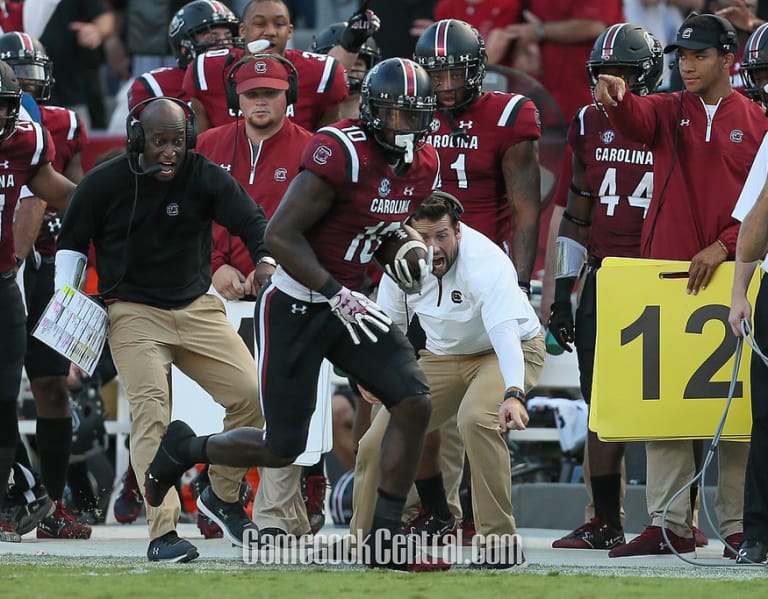Gamecock Fanatics
You are using an out of date browser. It may not display this or other websites correctly.
You should upgrade or use an alternative browser.
You should upgrade or use an alternative browser.
Countdown to Kickoff II: The Final 24 Days
- Thread starter Swayin
- Start date
Homebrewcock
GCF Top Poster
Homebrewcock
GCF Top Poster
Homebrewcock
GCF Top Poster
Homebrewcock
GCF Top Poster
The M10 tank destroyer was numerically the most important U.S. tank destroyer of World War II. It combined thin but sloped armor with the M4's reliable drivetrain and a reasonably potent anti-tank weapon mounted in an open-topped turret. Despite its obsolescence in the face of newer German tanks like the Panther and the introduction of more powerful and better-designed types as replacements, the M10 remained in service until the end of the war. During World War II, the primary user of the M10 tank destroyer was the United States, but many were Lend-Leased to the United Kingdom, Canada and Free French forces. Several dozen were also sent to the Soviet Union. Post-war, the M10 was given as military surplus to several countries, such as Belgium, Denmark, and the Netherlands, through the Mutual Defense Assistance Act or acquired through other means by countries like Israel and the Republic of China.
The M10 is often referred to by the nickname "Wolverine", but the origin of this nickname is unknown. It is possibly a postwar invention. Unlike other vehicles such as the M4 Sherman, M5 Stuart light tank, or M7 Priest self-propelled artillery (which picked up British service names but which were rarely used by US forces during the war), the M10 was never assigned a name or referred to with one when used by American soldiers.

On a side note, the image above is from the Aberdeen Proving Grounds ordnance museum in Aberdeen, MD - a fascinating place if you are into tanks.
The M10 is often referred to by the nickname "Wolverine", but the origin of this nickname is unknown. It is possibly a postwar invention. Unlike other vehicles such as the M4 Sherman, M5 Stuart light tank, or M7 Priest self-propelled artillery (which picked up British service names but which were rarely used by US forces during the war), the M10 was never assigned a name or referred to with one when used by American soldiers.

On a side note, the image above is from the Aberdeen Proving Grounds ordnance museum in Aberdeen, MD - a fascinating place if you are into tanks.
USS Albany (CG-10)
_in_1971.jpg/1280px-USS_Albany_(CG-10)_in_1971.jpg)
Formerly CA-123
_underway_1955.jpg/1280px-USS_Albany_(CA-123)_underway_1955.jpg)
_in_1971.jpg/1280px-USS_Albany_(CG-10)_in_1971.jpg)
Formerly CA-123
_underway_1955.jpg/1280px-USS_Albany_(CA-123)_underway_1955.jpg)
https://en.wikipedia.org/wiki/USS_Albany_(CA-123)USS Albany (CA-123) was a United States Navy Oregon City-class heavy cruiser, later converted to the guided missile cruiser CG-10. The converted cruiser was the lead ship of the new Albany guided missile cruiser class. She was the fourth ship to carry the name Albany.
https://en.wikipedia.org/wiki/Oregon_City-class_cruiserThe Oregon City class was a class of heavy cruisers of the United States Navy. Although it was intended to build ten, only four were completed – one of those as a command ship. The three ships completed as cruisers were in commission from 1946 to 1970.
Design and development
The Oregon City-class cruisers were a modified version of the previous Baltimore-class design; the main difference was a more compact pyramidal superstructure with single trunked funnel, intended to improve the arcs of fire of the anti-aircraft (AA) guns. The same type of modification also differentiated the Cleveland and Fargo classes of light cruisers.
USS Tennessee (ACR-10)
.jpg)
Memphis was driven onto the rocks by 3 large waves 75-100'-tall and lost while anchored at Santo Domingo on 29 August 1916.
The story of the loss of the Memphis serves as a good account of how dangerous things were in some parts of the world before the advent of the modern NOAA and the National Hurricane Center agencies.
.jpg)
History buffs will recognize that Captain Beach's son, Edward L. Beach, Jr., after retiring from the Navy became well-known as an author of both fiction and non-fiction books. His most famous non-fiction work Run Silent, Run Deep was published in 1955 and was made into a film by the same name in 1958 starring Clark Gable and Burt Lancaster.The second USS Tennessee (ACR-10), also referred to as "Armored Cruiser No. 10", and later renamed Memphis, was a United States Navy armored cruiser, the lead ship of her class.
She was laid down by the Cramp Shipbuilding Company of Philadelphia on 20 June 1903, launched on 3 December 1904, sponsored by Ms. Annie K. Frazier (daughter of Governor James B. Frazier of Tennessee and later the foundress of the Society of Sponsors of the United States Navy), and commissioned at the Philadelphia Navy Yard on 17 July 1906, Captain Albert Gleaves Berry in command.
Operational career
Placed in reserve at the Portsmouth Navy Yard on 15 June 1911, she remained on the east coast for 18 months before departing Philadelphia on 12 November 1912 for the Mediterranean. Arriving off Smyrna (now İzmir), Turkey on 1 December, she remained there protecting American citizens and property during the First Balkan War until 3 May 1913, when she headed home. After reaching Hampton Roads on the 23rd, Tennessee operated on the East Coast until entering the Atlantic Reserve Fleet at Philadelphia on 23 October. On 2 May 1914, she became receiving ship at the New York Navy Yard.
On 4 November, Tennessee arrived in Beirut, what was then Syria, to protect the Christian population there in case of attack by Syrian Muslims.
On 6 August, Tennessee sailed from New York for duty in Europe through the first half of 1915 supporting the American Relief Expedition by carrying gold bullion and other resources to assist in the extraction of American refugees from war-ravaged Europe. In August, she transported the 1st Regiment, Marine Expeditionary Force, and the Marine Artillery Battalion to Haiti. From 28 January-24 February 1916, the cruiser served as flagship of a cruiser squadron off Port-au-Prince, Haiti. In March, she embarked a group of dignitaries at Hampton Roads for a two-month, round trip cruise to Montevideo, Uruguay.
On 25 May 1916, Tennessee was renamed Memphis, honoring the city of Memphis, Tennessee, so that the name "Tennessee" could be reassigned to the new battleship Tennessee (BB-43).
In July 1916, under the command of Captain Edward L. Beach, Sr., the ship got underway for the Caribbean arriving at Santo Domingo on 23 July for peace-keeping patrol off the rebellion-torn Dominican Republic.
Memphis was driven onto the rocks by 3 large waves 75-100'-tall and lost while anchored at Santo Domingo on 29 August 1916.
https://en.wikipedia.org/wiki/USS_Tennessee_(ACR-10)Loss
Memphis was at anchor .5 nmi (0.58 mi; 930 m) off a rocky beach in 45 ft (14 m) of water in the harbor of Santo Domingo on the afternoon of 29 August 1916 with two of her 16 boilers operating in case she needed to get underway; the gunboat Castine also was anchored in the harbor. Shortly after 12:00, Memphis began to roll heavily and Captain Beach observed an unexpected heavy swell developing. Memphis and Castine both made preparations to leave the harbor and began to raise steam; Memphis expected to be able to get underway at about 16:35.
Conditions in the harbor had deteriorated badly by 15:45, when Memphis sighted an approaching 75 ft (23 m) wave of yellow water stretching along the entire horizon. By 16:00, the wave was closer, had turned ochre in color, and had reached about 100 ft (30 m) in height; at the same time, Memphis was rolling 45°, so heavily that large amounts of water cascaded into the ship via her gun ports and water even was entering the ship via ventilators 50 ft (15 m) above the waterline. By 16:25, water began to enter the ship via her funnels, 70 ft (21 m) above the waterline, putting out the fires in her boilers and preventing her from raising enough steam to get underway. She began to strike the rocky harbor bottom at 16:40, damaging her propellers just as she was raising enough steam to begin moving, and her engines lost steam pressure.
At about this time, the giant wave Memphis had seen approaching over the past hour arrived; she rolled into a deep trough and was struck immediately by what proved to be three very large waves in rapid succession, the highest of them estimated by the crew to have been 70 ft (21 m) in height, completely swamping her except for her highest points, and washing crewmen overboard. The waves rolled her heavily, caused her to strike the harbor bottom, then pushed her to the beach .5 nmi (0.58 mi; 0.93 km) away. By 17:00, she had been driven under cliffs along the coast of the harbor and was resting on the harbor bottom. She was battered into a complete wreck in 90 minutes.

Castine, meanwhile, managed to reach safer waters by getting underway and putting to sea through the large waves, although damaged by them and at times in danger of capsizing.
Memphis's casualties numbered 43 men dead or missing – 10 of them washed overboard by the waves or killed by steam as the ship's powerplant broke up, another 25 lost as they returned from shore leave in the ship's motor launch and were caught in the harbor by the huge breakers, and eight more lost in three boats wrecked after dark as they attempted to reach shore – and 204 badly injured. Due to their heroic actions during this incident, Chief Machinist's Mate George William Rud, Lieutenant Claud Ashton Jones, and Machinist Charles H. Willey were awarded the Medal of Honor.
Alternative explanations for the wreck
In his 1966 account of the incident, The Wreck of the Memphis, Captain Beach's son, Edward L. Beach Jr., ascribed her loss to an unexpected tsunami exceeding 100 ft (30 m) in height, and this explanation has been carried forward by most sources discussing her loss. More recent research, however, has called this explanation into question. No record of any seismic event in the Caribbean on 29 August 1916 that could have triggered a tsunami has been found, and the rate of advance of the large wave Memphis reported – about an hour to cross the distance from the horizon to the ship – matches that of a wind-generated ocean wave (possibly a rogue wave); a tsunami, in contrast, would have covered the distance in only a few minutes. The periods of the three large waves that struck Memphis also are characteristic of large wind-generated waves rather than tsunamis.
A likely source for such large, wind-generated waves in Santo Domingo Harbor on 29 August 1916 does exist, in that three hurricanes active in the Caribbean between 12 August and 2 September 1916 passed westward just to the south. Waves generated from these storms could well have combined to create a large wave like those that struck and wrecked Memphis. Such a circumstance appears to explain the loss of the ship better than the tsunami theory.
Oceanographer Dr. George Pararas-Carayannis in particular published an extensively detailed rebuttal demonstrating that a tsunami could not have caused the foundering of Memphis, but that the last of the three hurricanes, category 2 Hurricane Eight, likely did, creating a 59 ft (18 m) wave that reached a breaker height of 90 ft (27 m) as it approached Memphis. This swamped the cruiser, anchored in only 55 ft (17 m) of water, and would have done so even had the ship been at full maneuvering power. Pararas-Carayannis concluded that had Memphis been anchored in 100 to 120 ft (30 to 37 m) of water, she would have ridden out the swells, including the killer wave.
The story of the loss of the Memphis serves as a good account of how dangerous things were in some parts of the world before the advent of the modern NOAA and the National Hurricane Center agencies.
Last edited by a moderator:
10cc
#10 PK Bobby Marino from Atlanta, GA (1972-75)
Kicking
Year
FGA
FGM
XPA
XPM
Pts
1972
1
1
0
0
3
1973
12
9
40
38
65
1974
10
4
12
12
24
1975
17
10
36
34
64
Tot
40
24
88
84
156
Bobby Marino only kicked one FG during his Freshman season in 1972, but it was the game winner in a 24-21 upset win over a ranked Florida State team that destroyed FSU's Peach Bowl invitation hopes. The 1972 season was also the first one where Freshmen were allowed to play on the varsity team due to a much-welcomed NCAA rule change.
Marino kicks the winning FG against FSU in 1972 with 1:28 left in the 4th quarter. (below)

The win was the first one ever against FSU up to that time and provided a much-needed highlight to an otherwise dismal season where we finished 4-7 after losing to Clemson 7-6 in the final game of the season. The three picks made by Neville Files from Greenwood, SC, in the FSU game were good enough for him receive mention in Sports Illustrated.

Notice the special black Scholarship/Leadership helmet worn by Dietzel's Seniors back then that was mentioned in another thread.
Sa-lute!
Kicking
Year
FGA
FGM
XPA
XPM
Pts
1972
1
1
0
0
3
1973
12
9
40
38
65
1974
10
4
12
12
24
1975
17
10
36
34
64
Tot
40
24
88
84
156
Bobby Marino only kicked one FG during his Freshman season in 1972, but it was the game winner in a 24-21 upset win over a ranked Florida State team that destroyed FSU's Peach Bowl invitation hopes. The 1972 season was also the first one where Freshmen were allowed to play on the varsity team due to a much-welcomed NCAA rule change.
Marino kicks the winning FG against FSU in 1972 with 1:28 left in the 4th quarter. (below)
The win was the first one ever against FSU up to that time and provided a much-needed highlight to an otherwise dismal season where we finished 4-7 after losing to Clemson 7-6 in the final game of the season. The three picks made by Neville Files from Greenwood, SC, in the FSU game were good enough for him receive mention in Sports Illustrated.
Notice the special black Scholarship/Leadership helmet worn by Dietzel's Seniors back then that was mentioned in another thread.
Sa-lute!
Last edited by a moderator:
Since we have a lot of ships on this thread, I am going to take a slight detour for a real-time submarine history lesson courtesy of the USS Cod (SS-224). The Cod is a WW2-era Gato-class submarine that has been a memorial in Cleveland, OH, since 1959. The video below shows it's first dry-docking for hull repairs in Erie, PA, since 1963 and is a good lesson on what goes on in a Navy dry-dock during a ship's maintenance periods.
https://en.wikipedia.org/wiki/USS_Cod
http://usscod.org/
https://en.wikipedia.org/wiki/USS_Cod
http://usscod.org/
Last edited by a moderator:
USS Brooks (APD-10). Formerly DD-232.
_underway_during_trials_in_1920.jpg/1280px-USS_Brooks_(DD-232)_underway_during_trials_in_1920.jpg)
_underway_during_trials_in_1920.jpg/1280px-USS_Brooks_(DD-232)_underway_during_trials_in_1920.jpg)
https://en.wikipedia.org/wiki/USS_Brooks_(DD-232)World War II
As a patrol and escort ship, Brooks operated between California, Washington, and Alaska during the first year of World War II. On 20 September 1942, she arrived at Seattle, to commence conversion to a high-speed transport. On 1 December 1942, her classification was changed to APD-10 and she was assigned to the South Pacific.
WWII Pacific stations
She served as a transport and minesweeper during the Lae, New Guinea, landings (4–14 September 1943); Finschhafen, New Guinea, landings (22 and 29–30 September); Cape Gloucester, New Britain, assault (26 and 28–29 December); Saidor, New Guinea, landings (2 January-17 February 1944); Admiralty Islands landings (29 February-5 March and 19 March); Hollandia, New Guinea, assault (22–28 April); capture of Saipan (14–22 June); Leyte occupation (18 November-4 December); Mindoro invasion (12–18 December); and the Lingayen Gulf, Luzon, landings (3–6 January 1945).
Fate
At 1252 on 6 January 1945, the worst day for the Navy during the costly Invasion of Lingayen Gulf, a Japanese kamikaze crashed into Brooks' port side, causing extensive damage and starting a fire amidships. The main and auxiliary steam lines were severed, the fire main was broken, and the sea valve to the condenser was pierced, causing the forward engine room to flood. Three of Brooks' crew were killed and 11 wounded.
A number of Brooks's abandoned survivors, were rescued by the adjacent HMAS Warramunga (I44) and later transferred to her sister ship the USS Hovey, a minesweeper staged in Minesweeping Unit 1 for the Lingayen invasion, as was Brooks. Five more of Brooks's crew were killed when the USS Hovey was sunk by an aerial torpedo at 0455 on the following morning of 7 January. The badly damaged Brooks was towed to San Pedro, California, and decommissioned there on 2 August 1945. Brooks was sold 30 January 1946.
Awards
Brooks received the Navy Unit Commendation and six battle stars for her World War II service.
Last edited by a moderator:
Awesome Bill from Dawsonville




:format(jpeg)/cdn.vox-cdn.com/uploads/chorus_image/image/50451303/499065714.0.jpg)
:format(jpeg)/cdn.vox-cdn.com/uploads/chorus_image/image/47758859/usa-today-8957752.0.jpg)










